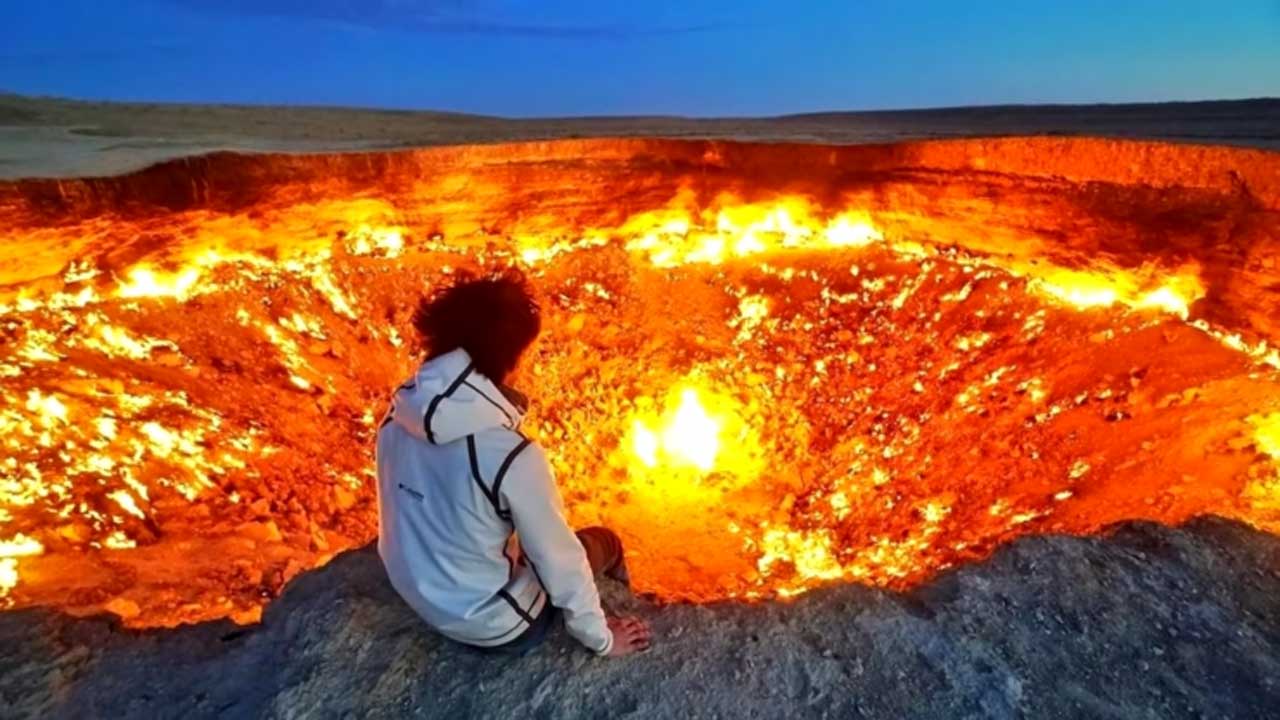There are many beautiful places and sights in Turkmenistan that have been preserved since the times of the first states. Dip.org.ua with a link to Turkmenportal.com will tell a little about these places.
The material opens the list of historical, natural, archaeological, climatic monuments of Turkmenistan, which are worth visiting at least once in a lifetime.
Dinosaur plateau
This is a unique place. The plateau is a limestone slab measuring 400×300 meters, which tilted at an angle of 120 degrees at a height of 1500 meters. About 1,500 pairs of well-preserved dinosaur footprints and 31 trails have been recorded in this area. This is the largest collection of dinosaur footprints in one place on the planet. Scientists suggest that this area millions of years ago was a swamp or shallow water. Gradually the swamps dried up and petrified. In the course of mountain-building processes, this place rose above the ground and tilted. Over time, the upper layers of the soil were washed away, and the real miracle of paleontology was revealed to people.
Cave complex Ekedeshik
This is a cave city built before our era, and in translation from the Turkmen language the name means “one hole”. From the name it becomes clear that the complex has one entrance, so it is almost impregnable. The cave consists of two floors: on the lower floors, the former inhabitants collected water from underground sources, on the upper floors there were living and kitchen premises, halls and an altar.
Karlyuk caves
Incredibly beautiful karst caves of Koytendag. Dozens form the unique natural dungeon of Koytendag. Karlyuk caves are the most famous in Turkmenistan. These are typical manifestations of various forms of karst. In total, about 60 caves have been registered, the total length of which is more than 50 kilometers.
Lake Kow-Ata
One of the most famous and visited tourist sites in Turkmenistan is the Bakharden Cave or Lake Kov-Ata. This is a 250-meter hall, the height of which decreases from 26 meters at the entrance to 3 meters near the lake itself, located at a depth of 55 meters. The air temperature is 20-25 °С in winter and 27-32 °С in summer. And the water temperature is 37 °C. The underground lake is considered curative because its water is rich in hydrogen sulfide and 26 other chemical elements. Archaeologists claim that the cave has been visited by people for over 2,000 years. Today it is equipped with a concrete descent, an observation deck and lighting.
Yangykala
The area on the ancient plateau Ustyurt. This surface was once under water and formed over millions of years on the site of an ancient ocean. The intense red color of the canyons is due to the presence of iron. Sands and clay were weathered, and the mineral matter, gradually compacting, turned into stones.
Darvaza
The gas crater in Turkmenistan, burning for more than 50 years, is known all over the world. In 1971, an oil rig collapsed and a crater formed, from which gas escaped. In order not to poison the environment, the gas was set on fire, and it is still burning.
Mud volcanoes
The coast of the ancient Caspian Sea with a monotonous desert landscape stretching for hundreds of kilometers, mud volcanoes continue to operate throughout this territory for millions of years. Periodically spewing mud masses and gases, often with hot water and oil. They are active, constantly changing position. From the most ancient volcanoes there were hills from the petrified materials of eruptions.
Depressions of the Karakum Desert
The Badkhyz Basin and its Yeroylanduz Depression is a deep drainless depression with an area of 300 square kilometers. In ancient times, the Tethys Sea stretched here. Over time, a unique depression formed on the site of active volcanic foci at the bottom of the sea. Today, here you can see the domed hills, which are the vents of extinct volcanoes. In spring and winter, the hollow is filled with melt water, forming a salt lake, and in summer – a flat salt marsh.
Gulf of Garabogaz
An unusual water formation is a bay-lagoon, which is located almost close to the Caspian Sea. They are separated by a narrow spit, and behind it is a narrow strait about 10 km long and no more than one kilometer at its widest point. The bay is located 4.5 meters below the level of the Caspian Sea. Therefore, the speed of the current reaches 1 meter per second (in some places – up to three meters), and here you can see such a phenomenon as a sea waterfall. Although its height is only 2 meters.
The list also includes the mountainous picturesque village of Nokhur, the waterfalls of Turkmenistan, among which the largest is Khur-Khuri, natural reserves of Turkmenistan, the ancient city of Merv, the Parthian capital Nisa, the architectural reserve Kunyaurgench, Gonurdepe, Dehistan, Abiverd and the Seyit Jamal ad-Din mosque.

